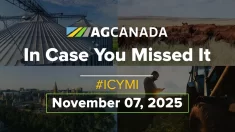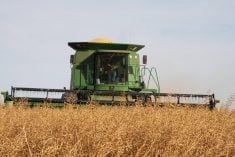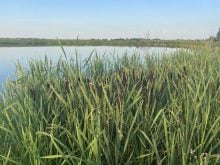VEREGIN, Sask. – A new line is being drawn across the rural Prairies. It divides the haves from the have-nots and could spell the difference between prosperity and poverty.
On one side are rural communities and farms that have access to high-speed internet, just like their city cousins.
Those that don’t have it run the risk of becoming areas where few people want to live.
“We’re second class citizens not having it,” said Debbie Manzuk-Bugera of Veregin, Sask., who operates Chautauqua Garden, a greenhouse and market garden in eastern Saskatchewan.
Read Also

Europe holds promise for Canadian lentils
Pulse Canada is trying to help boost lentil consumption in Europe, which is already the fourth largest market.
If customers phone her home to find out if the strawberries are ready to pick, they often get a busy signal because her two children have tied up the phone to get to the internet. They want to surf the net, check their Facebook accounts or play games. But what might take an urban teenager a few minutes takes rural teenagers hours because of poor internet service.
“My kids download all their music. It takes hours to download four or five songs,” said Manzuk-Bugera.
“Everything is slow. It’s a real pain to download anything.”
Manzuk-Bugera said she has considered getting high speed internet but balks at the cost. With no close towers for a line of sight connection, her only option would be satellite with high initial costs, pricey monthly fees and only medium high speed.
“I don’t want to spend that kind of initial money,” she said.
“I’m just resistant to it. I wish SaskTel had some rural set up. I don’t understand why can’t we just get it.”
Andy Tate of SaskTel media relations said the crown corporation’s goal is to cover as much of the province as possible with high speed internet, but bad jokes aside, there are places in Saskatchewan where you really can’t watch your dog run away for three days. Trees, terrain and technology often limit access.
SaskTel uses a network of towers to deliver wireless high speed to rural areas, helping it to provide 86 percent of the population with access to the service. However, if a farm family’s home is in a valley or surrounded by trees, they might be out of luck.
“Our goal is to connect as many people as we can, but it’s got to be economically feasible,” Tate said.
A report by the Alberta Council of Technologies found high speed internet is a rural economic enabler.
“Rural broadband is a necessary prerequisite to attract new business or enable existing business to grow,” said the report, which was prompted by frustration in rural areas with the lack of high speed internet.
“For early stage entrepreneurs, getting connected to an entrepreneurial network is a critical piece of the success equation, but the public sectors’ role in rural broadband development is ambiguous, hampering its completion,” it said.
Perry Kinkaide, president of the Alberta Council of Technologies, said dwindling rural populations mean rural businesses can’t rely on walk-in and drive-by traffic in their hometowns to pay the bills. Rural businesses need the internet to draw customers from around the world to help ensure success.
He said good internet access could stop the flow of people leaving rural areas for the cities and improve the quality of life for those who choose to stay.
“It may not create net in-migration, but it may stop the flow out,” said Kinkaide, who believes the internet will be the key to survival for many rural communities.
In central Alberta’s Beaver County, officials realized three years ago that residents of the sparsely populated county would never get wireless high speed if the local government didn’t build internet towers.
An independent internet service company was unlikely to provide reliable service to the entire region, but internet was just as important to the county as roads and electricity.
Equity Internet, which Beaver County set up as an independent internet provider, now has 24 towers across the county, providing line of sight radio frequency high speed internet. Another eight towers are planned for next year and a series of smaller repeaters will provide almost 100 percent coverage.
“We are the last mile provider,” said Darren Popowich, director of broadband services for Equity Internet.
The Alberta SuperNet, a 13,000 kilometre wireless fibre optic cable laid across the province, is the backbone of Alberta’s internet. It connects 4,200 government health centres and offices, schools, libraries and hospitals in 429 communities. It’s up to private operators, telephone companies and municipal governments to use a combination of technology to make the final connection to homes and farms.
“The internet is a collection of technologies all mashed together,” Popowich said.
When hired six months ago, he was given a waiting list with 500 homes wanting service. This summer, 200 were connected, but each time a tower is installed, another 30 or 40 people in the surrounding area call wanting service.
Popowich’s goal is to connect 800 homes to Equity Internet in the next two years.
Darren Klein of Viking, Alta., said he was tired of his dial up internet.
“If you did anything with pictures on dial up it was painfully slow,” he said while watching Equity Internet staff set up the final connections to the tower built beside his silage pit.
“They were wanting to put a tower here and we were more than willing to oblige,” he said.
Kelly Rudyk, a member of Strathcona County’s internet task force in Alberta, said there has been a 180-degree shift in residents’ attitudes about access to internet in the past five years.
A bylaw passed in 2001 placed restrictions on the height of cell phone and internet towers and where they could be built. County residents saw the towers as a blight on the landscape.
“It’s quite remarkable how in a short space of time the attitude has made such a change,” Rudyk said.
Now, rural residents demand high-speed internet access.
“The internet has become a way of life and we’re having to respond to that,” he said.
With its rolling hills and dense trees, the county on the east edge of Edmonton is perfect for acreages but not for internet service. A survey showed almost 60 percent of residents still use telephone dial up service to access the internet.
“The biggest issue is topography,” Rudyk said.
After a year of surveying residents and talking to officials from across Canada who have tackled similar problems, the county is finalizing a set of guidelines and will ask private providers to bid on operating an internet service.
The county doesn’t plan to own the infrastructure but will act as a monitoring service to ensure guidelines are followed and service is provided.
By working with only one provider, the county hopes to spread towers across the region and allow access to most residents.














